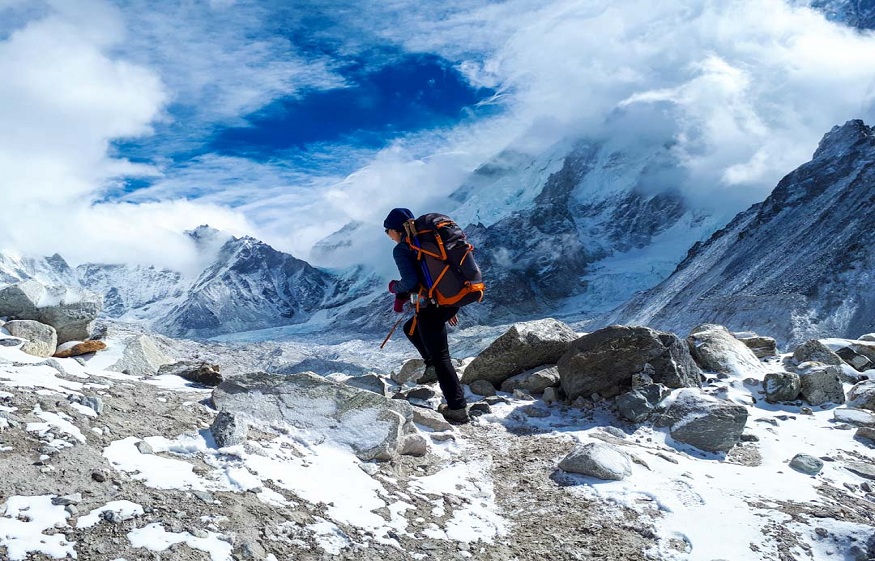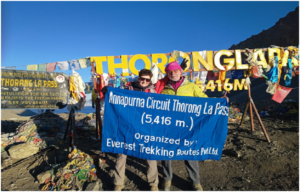Hiking to Everest Base Camp (EBC) is a once-in-a-lifetime adventure, however, with the increase in the number of trekkers to the region, we need to ensure that the experience is sustainable. Trekking sustainably is all about minimizing your impact on the environment, being respectful of local communities, and ensuring future generations can enjoy the same experience. Here are eight ways to make your Everest Base Camp trek greener and more culturally sensitive.
Choosing an eco-conscious trekking agency is one of the first steps to an eco-friendly trek. Responsible tour operators are aware of environmental concerns and encourage things like waste minimization, patronizing local businesses, and respecting the local culture. Choosing agencies that engage in sustainable practices can ensure your trek is beneficial to the region.
Everest Base Camp Treks Plastic waste is also another point of focus in sustainable trekking. Plastic waste is also a significant issue in the Everest region. By carrying a reusable water bottle that has a filtration system, you can refill your bottle at safe water sources along the trail, eliminating the need for single-use plastic bottles. Many teahouses have water refill stations as well to cut down on plastic waste.
Carrying out your trash and disposing of it properly is another key element of sustainable trekking. Because waste decays slowly in high-altitude areas where you might be trekking, it’s vital to pack out everything you pack in.” Use waste collection services provided by many teahouses and only dispose of waste in designated waste areas.
Another seed of sustainability lies in supporting local communities. As the people of the Everest region depend on tourism for their income, staying in locally-owned teahouses and buying goods and services from local shops can make a considerable difference in the local economy. It is also important to understand and respect local cultures and customs. Familiarising yourself with the habits of the Sherpa people, asking permission before taking pictures, and respecting cultural practices all help make sure that your trek is beneficial to the well-being of the local community.
Environmental responsibility is vital when trekking in Nepal, especially in places like Sagarmatha National Park, which is a UNESCO World Heritage site. Sticking to marked routes, keeping noise to a minimum, and not disturbing wildlife are all straightforward steps that all help reduce your impact on the landscape. Feeding animals not only stops their natural movement, but it also adversely affects their diet.
In your gear prep for the trek, it’s important to choose sustainable gear as well. Buy durable, quality equipment that lasts a long time and is made from eco-friendly materials. Instead, opt for equipment that is reusable for more than one trek in your life so that a zero-waste lifestyle can be a part of your travel, too.
Being an eco-friendly trekker on the Everest Base Camp trail takes purpose: from the kit you take with you to how you engage with the local environment and people you meet. By following some good practices, you’ll not just have a great holiday but also help preserve the Everest region for future trekkers. Sustainable trekking will protect the iconic beauty of this special destination, providing a rewarding experience to trekkers and locals.
Balance: Why You Should Care About Sustainable Trekking
Mount Everest Base Camp Trek like Everest Base Camp (EBC) are very popular, but sustainable trekking is necessary for the conservation of the trekking regions. As trekking grows in popularity, it’s important to lessen the impact on the ecosystem and local populations. Sustainable trekking practices focus on preserving the area’s ecosystem, minimizing waste, and making sure future generations can have similar experiences. With mindful choices, trekkers can help sustain the tension between adventure tourism and environmental conservation. By encouraging responsible travel, sustainable trekking supports local economies and promotes eco-friendly businesses. By trekking responsibly, you’re not only enriching your own experience but also ensuring that the region remains a travel paradise for generations to come.
Reducing Your Carbon Footprint for the Trek
It is sustainable trekking, not one of the ways to reduce your carbon footprint. The Everest Base Camp trek typically has you flying to and from Kathmandu and Lukla, which can be a big carbon hit. But there are steps you can take to lessen your carbon footprint. One option is to purchase carbon offsets for your flight, a fee that goes to greenhouse gas-abating projects. Walk the talk, literally: Stick to eco-friendly transport when trekking by using the local buses or trekking to Lukla instead of flying. And also travel as a group to minimize the number of vehicles used and share transport whenever possible. During the trek itself, choose walking over using other means of transport like helicopters or yaks, which also contribute to carbon emissions. Small substitutions are easy to implement, stamp out along the course of the journey, and can go a long way to help limit the overall environmental cost.
Trail Etiquette: Leave No Trace Trail Etiquette
Waste Management is among the most critical components of Sustainable Trekking. As with many popular trekking areas, the Everest region suffers from the accumulation of waste, especially plastic. We, trekkers, must reduce waste and handle it properly. BRING A REUSABLE WATER BOTTLE WITH A FILTRATION SYSTEM, MINIMIZING THE NEED FOR PLASTIC BOTTLES. All trash (food wrappers, tissues, etc.) should be packed out—nothing should be left behind. Most tea houses also have waste disposal services, Please stop using them. Do not litter; use proper trash receptacles. You can also support the eco-friendly initiatives by bringing biodegradable products or eco-friendly toiletries. As trekkers, it’s our responsibility to make sure we are responsible for what we leave behind, hence reducing the environmental burden and ensuring a cleaner trail. When trekking the Everest Base Camp trek, it is important to help make it cleaner and more sustainable, which is possible by working collectively with other trekkers and local guides.
Supporting Local Community and Environment-Friendly Companies
Everest Base Camp Environmental responsibility when trekking involves supporting local communities and eco-friendly businesses. Tourism is the lifeblood of the Everest region; so whatever trekkers spend, it must filter down to the residents. Connecting with the Local Culture: One way that you can do this is by staying in locally-owned teahouses and purchasing goods from local vendors. Supporting local businesses with the genuine intention of sustaining and maintaining our environment, culture, and resources. It can help ensure the local community benefits from tourism in ways consistent with environmental principles. In addition, many of these agencies will also fund projects that can aid in sustainable development, like waste management systems, conservation programs, or even local empowerment initiatives. When visiting eco-sensitive areas, be mindful of how your decision can have an impact on the local community and always try to give back in some way. Understanding and respecting local customs and traditions, and doing your part for eco-friendly practices, ensures tourism works in favour of people and the planet.
Gear and packing tips for more sustainable trekking
Using sustainable trekking gear is also essential in reducing environmental harm during your Everest Base Camp trek. Opting for high-quality, durable items means that we will be less likely to replace them often, reducing waste. Use sustainable gear such as eco-friendly clothing, water bottles , and biodegradable soaps. A water bottle with an integrated filtration system allows trekkers to drink from streams and rivers, reducing the need for plastic bottles that are often a scourge along trekking routes. It’s important to keep weight in mind when you pack, as excess items only lead to overpacking, which adds to your carbon footprint and can make the trek more difficult. Opt for a lightweight kit that will serve multiple purposes, and you will need less kit. Make sure your gear is in good shape when you set out, too — if any of your equipment breaks down during the trek, it can create waste. Effectively, by investing in eco-friendly trekking gear and planning your packing wisely, you can cut your carbon footprint and ensure a successful journey to Everest Base Camp.
Decrease the Use of Plastic and Encourage Reusability
Himalayan Base Camp Trek Minimizing plastic is one of the most effective changes you can make to walk sustainably, and especially on the Everest Base Camp trek, where plastic trash can pile up quickly. Trekking through such a pristine wilderness has necessitated a conscious effort to reduce plastic consumption. A simple yet convenient solution: Bring a reusable water bottle with a filter that provides you with fresh water without a single-use plastic bottle. Many trekking agencies now offer refill stations where you can refill the water you carry, thus cutting down even more on plastic waste. Also, minimize plastic packaging and use biodegradable or recyclable materials. Investing in reusable food containers, cutlery, and bags can also help reduce the amount of plastic waste you generate along the trail. This will help ensure that the stark beauty of the Everest region remains pristine for future trekkers — every plastic-free step you take will contribute to that end.
Fair Prices and the Role of Porters
Thus, porters are crucial to the well-being of trekkers and the success of the Everest Base Camp trek. We must do our utmost as trekkers to ensure porters are fairly treated and compensated for their hard work. 🙁 Many porters work under poor conditions and are paid poorly, so trekking companies that pay their porters a fair wage and provide equipment are an absolute must. Some companies even have porter protection programs, which also offer health and safety coverage. You may also contribute to fair wages by providing generous tips to porters, thanking them for their efforts. Some trekking agencies have even started porter training programs to ensure their porters work under safe conditions. Supporting ethical trekking companies means porters will be treated with respect, paid fairly, and given good working conditions.
Avoiding the mutilation of the local economy through trekking companies that maximize profit at the expense of the local population.
Everest Base Camps One of the best steps you can take to ensure that your trip has a positive impact in the Everest region is to book with an environmentally-conscious trekking company. These companies incorporate eco-friendly practices, from minimizing waste to reducing carbon footprints. Many are staffed by local citizens and contribute to sustainable development efforts like waste management, reforestation efforts, and environmental education programs. And many eco-friendly trekking companies make contributions towards or support conservation efforts that protect local wildlife and ecosystems. When choosing a trekking agency, be sure to check for certifications or endorsements by environmental organizations, which is a telling sign of the company’s commitment to sustainable practices. You can also ask about the company’s specific sustainability initiatives and how it minimizes the environmental footprint of its business. Choosing the right company means your adventure helps protect the Everest region and supports local communities.
Respecting Local Wildlife and Ecosystems
Keeping in mind wildlife and ecosystems is key to sustainable trekking. The Everest region has its unique flora and fauna, including endangered species such as the snow leopard and the red panda. When hiking, do not disturb wild animals or their homes, and do not feed the animals so that they do not develop an artificial lifestyle. Stay on designated paths and don’t trample vegetation. It can damage delicate ecosystems. Also, consider the effect your actions will have on the flora and fauna around you, and adhere to the “Leave No Trace” principles that advise human wilderness interference as little as possible. Avoiding plant-picking or trash-leaving, or unnecessary noise pollution, protects the region’s ecosystem, which is a fragile balance. Local wildlife and ecosystems are already under pressure, and taking care of our environment now helps ensure tomorrow’s trekkers experience the same richness and biodiversity we enjoy now.
Conclusion: The Positive Legacy of the Everest Region
Such a life-altering experience is going from a luxury to a necessity in this modern age, but we must ensure our impact on this pilgrimage is that of goodness. Sustainable trekking practices — minimise plastic use, pay porters fair wages, travel with eco-conscious companies, respect wildlife — help preserve the environment and support local communities. These responsibilities are also required not only to be a good mountaineer but also to be a good traveler in general, and to preserve the beautiful Everest region and the natural environment as a whole for future adventurers. Sustainable trekking isn’t just about reducing harm; it’s about leaving behind a positive legacy for people and the planet. So I hope that by being mindful, we help to keep one of the most spectacular treks in the world nice for everyone in the future.
Is Everest Base Camp Trek Ethical?
Everest Base Camp Trek Cost The Everest Base Camp (EBC) trek is one of the few ethical treks in Nepal if trekkers make conscientious decisions about the environment and local communities. “Waste management, overtourism, the strain of housing and locals as well, these are all challenges facing the region,” said Wayfinder co-founder Harlan Wallace. But if you select eco-friendly trekking companies, who put sustainability first, choose local guides and porters who are paid fairly, and follow responsible travel practices such as minimising plastic waste, the trek can make a positive impact. It is pledged through patronizing responsible and ethical trekking practices to contribute to the protection of the Everest region as well as benefiting local communities and the Sherpa people through tourism. That said, trekkers should be mindful of their environmental footprint and do their best to leave this delicate ecosystem as they found it.
How to Prepare for the Trek to Everest Base Camp?
Everest Base Camp Trek Preparation: How to Prepare? These include hiking, running, or cycling, which will all increase your stamina when completed to enhance your fitness levels. Focus on the following targeted exercises to strengthen your legs and core muscles, such: squats, lunges. If you are in a location that does not have access to relief, practice hiking on uneven ground or wearing a backpack as if you were going on an expedition. Acclimatization is key, so build yourself up to altitude by practicing at an that is higher than your base. You’ll also want to prepare mentally, getting ready for long, physically exhausting days will ensure you maintain your motivation. Lastly, check that you have all the required documents, permits, gear, and health precautions in order.
Is Mount Everest Sustainable?
Trek to Base Camp Mount Everest Mount Everest’s sustainability is becoming a concern due to increasing numbers of trekkers, climbing waste, and environmentally damaging waste accumulating on and near the peak. As it swings back into town, it’s faced challenges like pollution and deforestation, interfering with local wildlife. Various initiatives have been launched to address these problems, including waste collection initiatives, restrictions on the number of trekkers, and tougher regulations on climbers. However, sustainable tourism can only exist within Mount Everest if we keep striving towards responsible travel, eco-friendly practices, and improved waste management. Their beauty and the local ecosystem must be preserved for generations to come through sustainable practices.
How Do You Get Fit for the Everest Base Camp Trek?
Everest Base Camp Trek: Start preparing for the trek at least 4 to 5 months before you arrive at one. Start training 3-4 months before your trek, gradually building your fitness. You need cardiovascular fitness, so run, swim, and bike to build your stamina. Be Strong On Your Legs: Include lunges, squats, and step-ups in your training to help with the steep climbs. Since stability hinges on core strength, incorporate things like planks and leg raises into your workout. Train through uneven terrain to mimic the trek conditions, and perform training hikes with a loaded rucksack. If you can go hiking at a higher altitude for preparation, try that; otherwise, mimic the conditions by slowly increasing elevation during your preparation.



